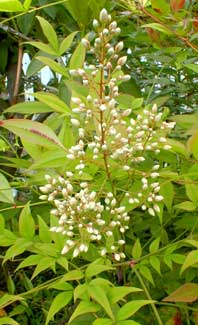
Heavenly Bamboo, Nanten or
Common Nandina
"When snow is white on moat & tree
& crusts each bamboo feather,
My Yuki lifts her eyes to me,--
'Tis all I know of weather."
-from "Yuki"
Mary McNeil Fenollosa
(fl. 1890s
Mary McNeil Fenollosa
(fl. 1890s
Nandina domestica is the only species within its genus. It has bamboo-like leaves so is commonly called Heavenly Bamboo or Sacred Bamboo, though it is related to barberries.
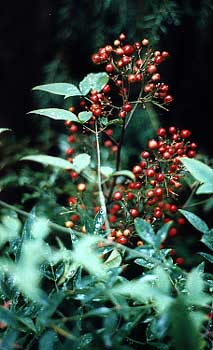 We have two distinct varieties. The one shown on the present page is "plain" or wild nandina, with rather pale green evergreen leaves that become dark green as the year progresses. Its partner is a named cultivar called 'Monum' or "Plum Passion," which has purple young leaves that age to green then turn purple again in autumn.
It will bloom as happily in shade as it will in full sun, but for the leaf colors to be most exciting, it should have some sun. In shade it has more of a tendency to become leafless on the lower portion, but in the main it is adaptable for a wide range of gardening conditions. In full sun it is leafy top to bottom.
We have two distinct varieties. The one shown on the present page is "plain" or wild nandina, with rather pale green evergreen leaves that become dark green as the year progresses. Its partner is a named cultivar called 'Monum' or "Plum Passion," which has purple young leaves that age to green then turn purple again in autumn.
It will bloom as happily in shade as it will in full sun, but for the leaf colors to be most exciting, it should have some sun. In shade it has more of a tendency to become leafless on the lower portion, but in the main it is adaptable for a wide range of gardening conditions. In full sun it is leafy top to bottom.The unnamed or natural specimen lacks 'Monum's' colorfully plum-purple spring leaves, but it can be nearly as colorful as 'Monum' for its late autumn colors. Furthermore, our plain specimen, during droughty summer in full sun, becomes interestingly sunburnt, as in the third & fifth photos from July (2005). Some of the pale green leaves turn bright carmine almost as though they've been unevenly painted.
Leaves that take on this color do not change back, but will eventually be replaced by new leaves. Not many specimens do this, & none do it in shadier locations; environmental conditions & the shrub's strain & temperatures & degree of sun & moisture all make nandina performances highly individualistic. The 'Monum' growing immediately beside the wild form nandina is in identical conditions but never gets this intensely carmine leaf.
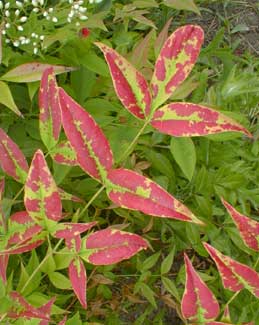 Two varieties are required to obtain good fruiting. The regular wild nandina as shown in the first photo in June (2003) showing the hard buds of a flower panicle. These buds open a few at a time through the month to follow. Cross-pollinated by 'Monum,' the wild nandina very slowly develops berries. The same panicle is shown in the second photo in November, the leaves having darkened & the berries ripened to bright red. There are more portraits of the fruit on the Nandina page of the Winter Berries Gallery.
Two varieties are required to obtain good fruiting. The regular wild nandina as shown in the first photo in June (2003) showing the hard buds of a flower panicle. These buds open a few at a time through the month to follow. Cross-pollinated by 'Monum,' the wild nandina very slowly develops berries. The same panicle is shown in the second photo in November, the leaves having darkened & the berries ripened to bright red. There are more portraits of the fruit on the Nandina page of the Winter Berries Gallery.There is usually a second flowering in September/October, which may not be successfully pollinated, so the later panicles dry out on the shrub & remain very decorative. Right into the following spring, there'll be bud-panicles & red-berries side-by-side upon the shrub. If clipped for bouquets, well dried autumn/winter panicals (with or without maturing berries on them) last indefinitely for flower arranging.
Because it has sacred associations, & because nandina will have unpollinated flowers throughout winter, or sprays of red berries, it is a shrub identified with Chinese Kitchen Day. This "pre-New Year" Taoist holiday falls on December 23. The kitchen & dining area are decorated with cuttings of nandina leaves, fruits, & flowers, or winter-forced narcissi, & there is a family reunion dinner is held after sundown. Offerings of sweets, soybeans, water, or grass (for the Kitchen God's horse) are presented to the Kitchen God, who sits most of the year in a little shrine in the kitchen. Such offerings & prayers are made by the male head of household, in accordance with the saying, "Men do not worship the Moon, & women do not make offerings to the Kitchen God."
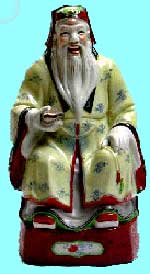 On December 24, the Kitchen God who sits in a little shrine in the kitchen will be put away, for that is the day the Kitchen God rides his horse to the Celestial Palace in order to present a report to the Jade Emperor on the family's deeds & conditions. The house is cleaned during his absence, then he is restored ot his little shrine on December 30, the day when all the gods & ancestors come to earth to party with mortals. At New Year's close, paper palanquins & paper horses are burned to symbolize the gods returning to heaven, & three small cups of liquor are sprinkled around.
On December 24, the Kitchen God who sits in a little shrine in the kitchen will be put away, for that is the day the Kitchen God rides his horse to the Celestial Palace in order to present a report to the Jade Emperor on the family's deeds & conditions. The house is cleaned during his absence, then he is restored ot his little shrine on December 30, the day when all the gods & ancestors come to earth to party with mortals. At New Year's close, paper palanquins & paper horses are burned to symbolize the gods returning to heaven, & three small cups of liquor are sprinkled around.For this holiday, nandina branches with berries hold a position very similar to berried branches of holly for Christmas in the west. In Japan as well as China Nandina symbolizes sacred celebration. Therefore a few leaves with or without berries will frequently be used as a decorative garnish on dishes identified as of celebratory significance, though the berries are mildly toxic & are not eaten.
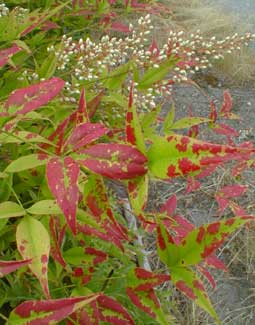 In Chinese Nandina means "south heaven," because of its association with the lucky gods. Written in Japanese kanji script, it means "hardship reversal." So nandina is also a typical gift for a new homeowner as a symbol of joyful good luck for the newly established household.
In Chinese Nandina means "south heaven," because of its association with the lucky gods. Written in Japanese kanji script, it means "hardship reversal." So nandina is also a typical gift for a new homeowner as a symbol of joyful good luck for the newly established household.Any sacred plant will inevitably be used as a medicinal herb, with or without known efficacy, for to use it is like a prayer. The berries are so mildly toxic that it is probably a harmless superstitious practice to use them as pills, though it is not recommendable to the unfaithful. The dried berries are used for cough in traditional Chinese medicine, & tonics derived from the bark & the root-bark are used for eye conditions, flu, muscle pain, rheumetism, fever, & gastrointestinal illness. Doubleblind studies to substantiate or debunk the essentially religious use of nandina has as yet provided nothing conclusive. Its use should in any case be restricted because of its known toxicity, & it may be especially harmful for pregnant mothers. Extracts with excessive use can cause respiratory shut-down with attendant risk of death.
It is not out of the question that some medicinal benefit may be had from Heavenly Bamboo's major alkaloid components, including nantenine. A 2002 study conducted by Indra et al of the Department of Molecular Biology, Tohoku University, showed an ability of nantenine to block chemically induced head-twitching behavior in mice. Its potential benefits or harmful side-effects with human use are as yet poorly documented, but it is a credible hypothesis that its sundry alkaloids & flavanoids would be as useful as those from many other barberry-family shrubs.
As to care, Heavenly Bamboo adapts to any acidic soil condition, & prefers continuous moisture but when established will tolerate intermitant periods of drought without complaint. It is not prone to disease or insect attack, & in temperate zones is low maintenance.
Grown in colder zones, it is deciduous where winters fall to ten degrees Fahrenheit, & a die-back perennial where temperatures fall to zero. It is strongly evergreen on Puget Sound (zone 8). It likes a bit of shade but tolerates full sun on Puget Sound; inland it might not tolerate full sun, but would prefer partial sun to bright shade.
It may after a few years begin to sucker a bit. Suckers can be clipped away to preserve a single trunk, or encouraged in order to correct the shrub's tendency to be less leafy underneath. The dwarf varieties excepted, Nandina left to itself will eventually reach ten feet tall, but if skillfully pruned can be kept smaller & more compact. If grown in shade, they will be leggier & leafless toward the bottom, but still fruit & flower well; in a sunnier spot they will be more broadly bushy.